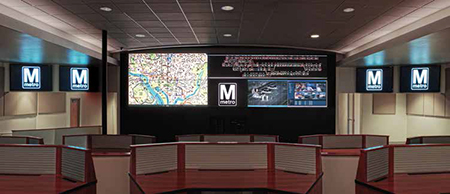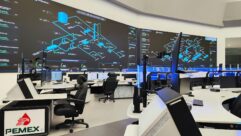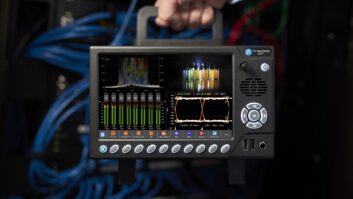

It’s getting tougher to be a criminal, at least on Washington, DC public transportation. “If you’re a criminal, you’re going to pass by one of our cameras,” says Shawn Doody, digital video evidence manager for the Metro Transit Police Department and manager of the agency’s new Security Operations Command Center (SOCC). “We’re going to find you.” Video from thousands of cameras is digitally stored and accessible from the agency’s security network, giving operators at SOCC the ability to call it up quickly for an investigation or a trial.
At the heart of the new Command Center is a 27-foot wide, 11-foot high Mitsubishi Electric display wall, which enables operators and dispatchers to see multiple live and recorded video feeds at remarkably high resolution. It’s the culmination of more than 15 years of coordination and experimentation by police and the Washington Metropolitan Area Transit Authority (WMATA).
In 2001, Doody and William Taylor, a communications design engineer for WMATA, added a centralized recording system and set up remote viewing capability at several Metro Transit Police locations. In 2008, the pair began experimenting with a centralized viewing center, which became the predecessor to SOCC. “Bill put together a test to see how it would work,” Doody recalls. “We had four workstations, each with four local monitors plus three 52-inch monitors that the operators could share.”
Now the new Command Center in Action SOCC consists of two main areas: up front there are 10 computer workstations for video operators, who are employees of WMATA. Above and behind them are five more workstations for Metro Transit Police dispatchers. Video from the surveillance cameras is shared on the Mitsubishi display wall, which consists of 10 VS- 72WEF78S 1920×1200 LED projection cubes, arranged in a 2-high by 5-wide configuration. In addition, there are six 65-inch LCD flat-panel displays mounted on the side walls.
Because officers in the field carry tablet computers, operators can send screen captures or video clips to them as they arrive on a crime scene. “If a witness says the person was wearing blue and brown, we can send an image showing that it was brown pants and a blue shirt, we know the shade of blue, and we can probably see his face as well,” Doody explains.
In addition to the video wall, integrator Washington Professional Systems installed a Jupiter video wall processor, Crestron DigitalMedia technology with a 32×32 switcher, and a Crestron control system. CNL IPSecurityCenter software runs on each of the video operators’ workstations.
“It’s a really simple interface that allows the WMATA operators to put things up on the wall very quickly,” adds Eric Choucroun, senior account executive for Washington Professional Systems.
In addition to the cameras, operators can display a dynamic rail map that shows the location of every train and the direction it’s headed in real time, cable news feeds, and images from a Cisco video conferencing system that allows dispatchers or managers to communicate with their counterparts in other locations.
PRODUCT AT WORK
Mitsubishi VS-72WEF78S
This front-access, LED, rear-projection cube employs a mechanism that allows the screen to swing open, allowing clear access for installation, wiring, and service to be done through the front of the unit, so the cubes can be placed directly against a wall.
me-vis.com
from the wire
For more case studies, visit svconline.com/wire.










